20/12/2014
Formicarium making: This formicarium was originally planned for Polyrhachis Sp., but this Camponotus Sp. is much faster growing.




Edited by antmaniac, February 17 2015 - 7:57 PM.

20/12/2014
Formicarium making: This formicarium was originally planned for Polyrhachis Sp., but this Camponotus Sp. is much faster growing.




Edited by antmaniac, February 17 2015 - 7:57 PM.
Queen: when she first arrived and egg laying.
28/12/2014

30/12/2014








Development throughout January 2015.
18/1/2015

27/1/2015


28/1/2015

Edited by antmaniac, February 18 2015 - 5:21 AM.
Cocoons, more cocoons and moving in to the formicarium.
3/2/2015
1 cocoon


4/2/2015

7/2/2015
4 cocoons





9/2/2015
5 cocoons


17/2/2015
7 cocoons

18/2/2015
8 cocoons

Edited by antmaniac, February 18 2015 - 5:25 AM.
Nice pics ! Especially the ones with the queen laying eggs... Do you now what species is it ?
And just a question : why did you put her directly in a nest ? You could have put her in a test tube and you would not have to care for moistering the nest every day...
Nice pics ! Especially the ones with the queen laying eggs... Do you now what species is it ?
And just a question : why did you put her directly in a nest ? You could have put her in a test tube and you would not have to care for moistering the nest every day...
I am guessing it is a Camponotus species, a small variety of the sugar ant. http://www.qm.qld.go...ts#.VOPDRvmUc8S This link got some useful information on this species.
In the earlier stage, I put the queen in a container with foods and used a piece of paper soaked in water to provide the necessary water source. It would last for 2 to 3 weeks at least in the indoor environment. Usually by that time, I need to clean out the nest anyway. When the nanitic workers are about eclose, I move them to the formicarium. The draw back of this is that the queen would not go out and feed on the foods, but soon the nanitic workers will carry out this task for the colony anyway.
As for the formicarium, the take away container can hold a lot of water. It probably last for 1 to 2 months before I actually need to refill the water again if placed in indoor environment. As for outdoor, usually the snails would come and drink the water. But I have one similar formicarium lasted for 6 months in an outdoor environment, purely from the rain and condensation.
Edited by antmaniac, February 18 2015 - 4:27 AM.
22/2/2015
The very first nanitic worker, still pale and tumbling. Welcome to the world, little guy.

27/2/2015
I was fortunate enough to see the second nanitic worker eclose. The first nanitic is like a big sister tending the new sister.
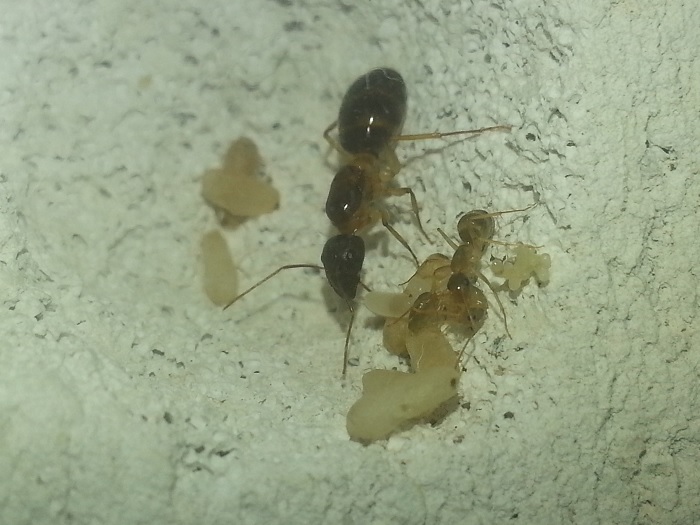
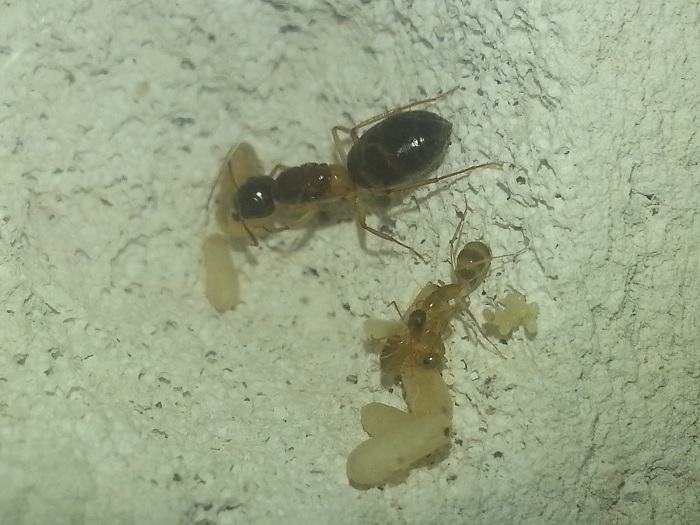
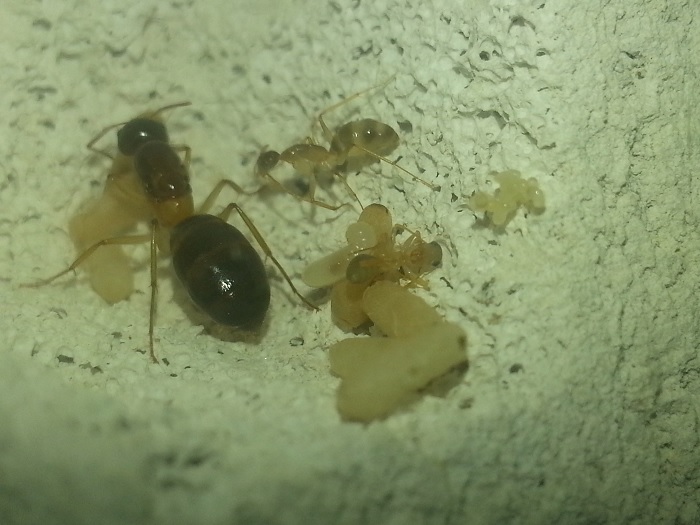
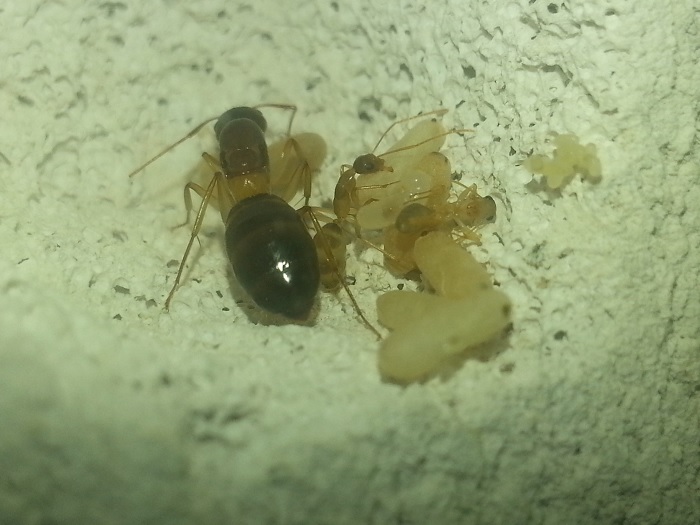
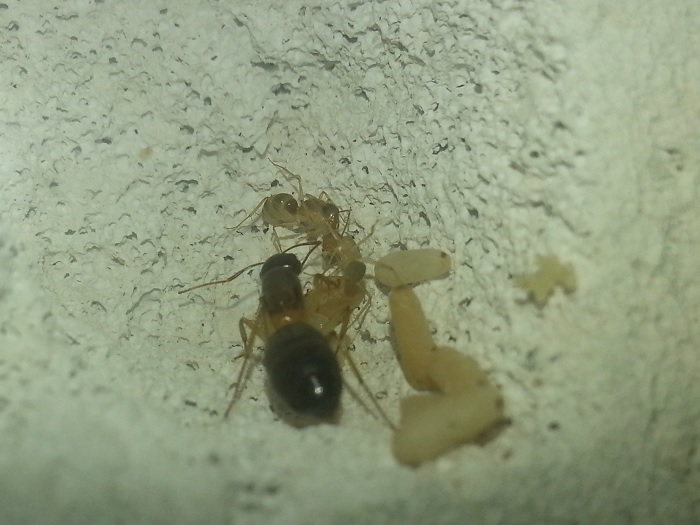
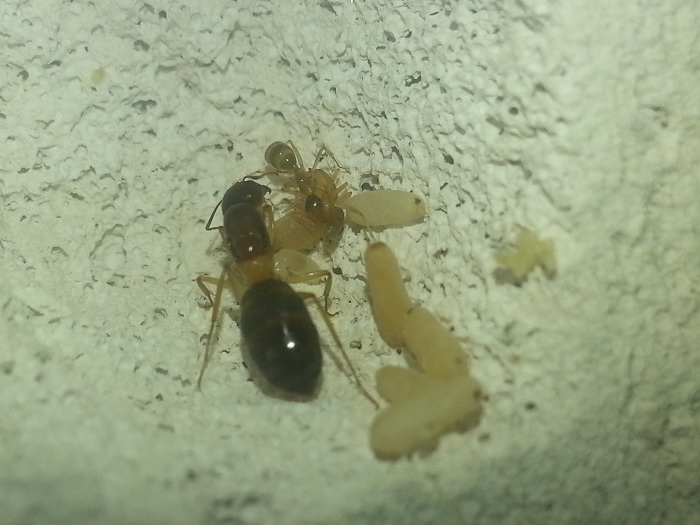
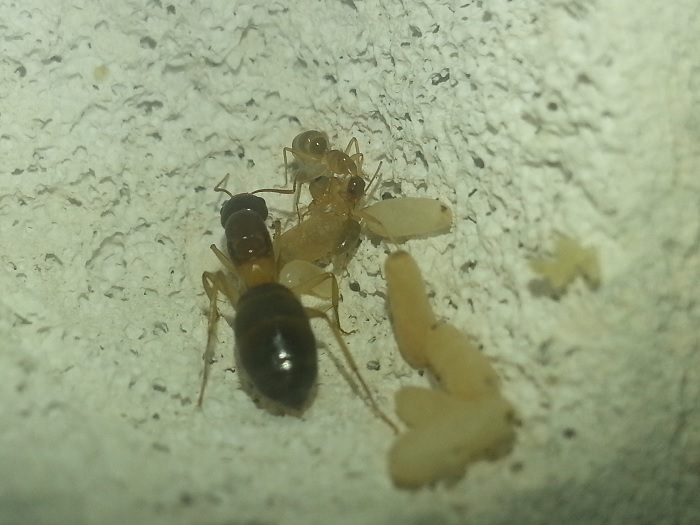
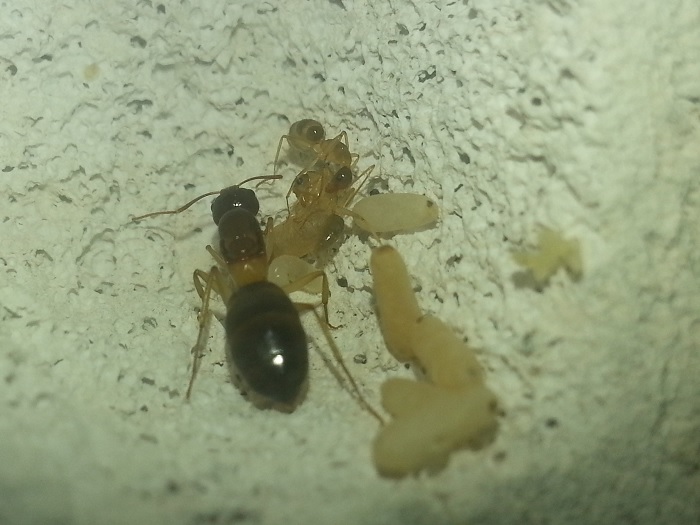
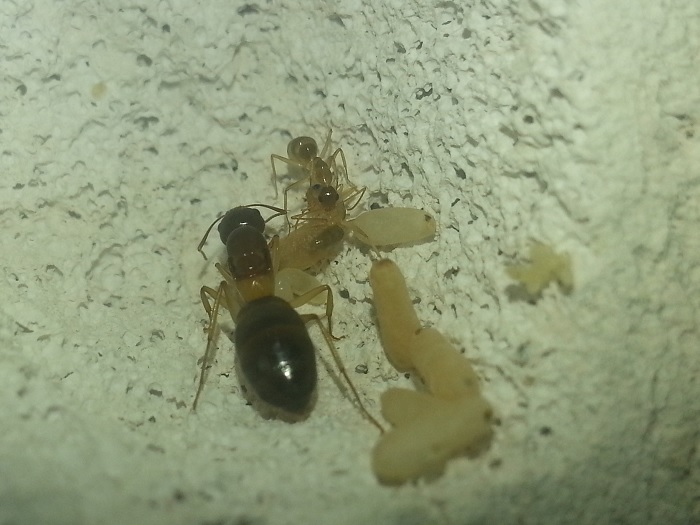
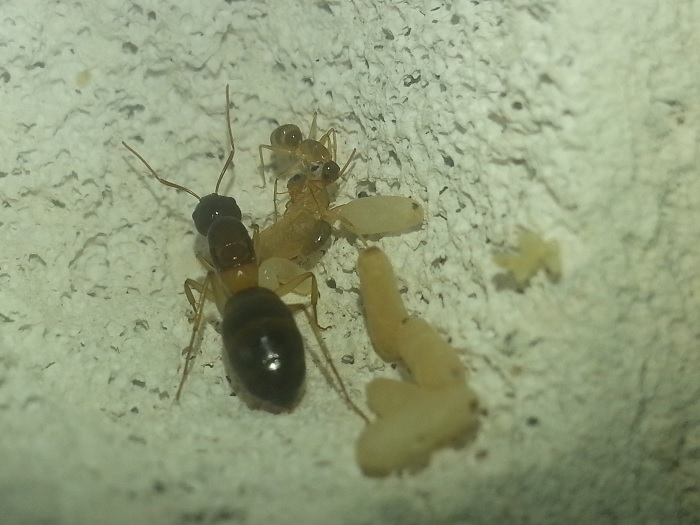
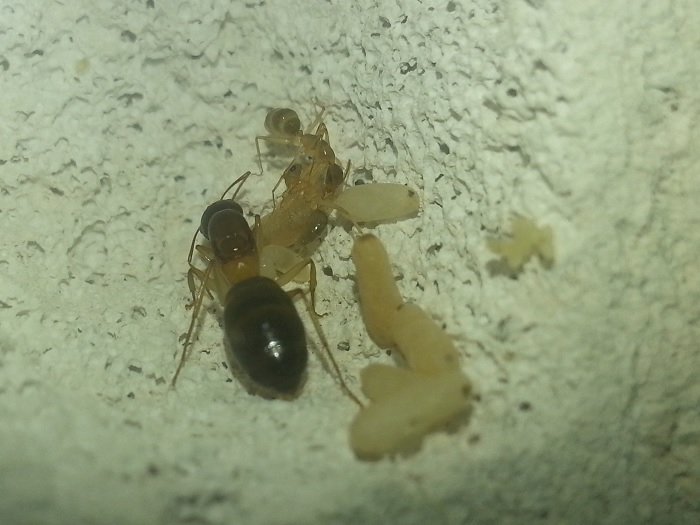
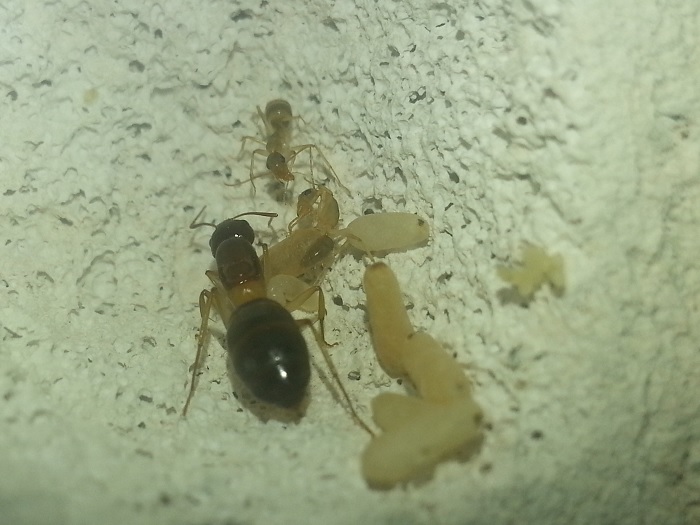
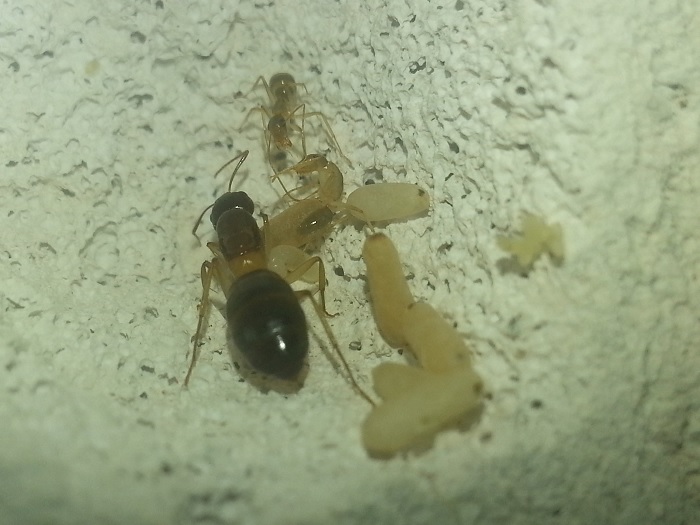
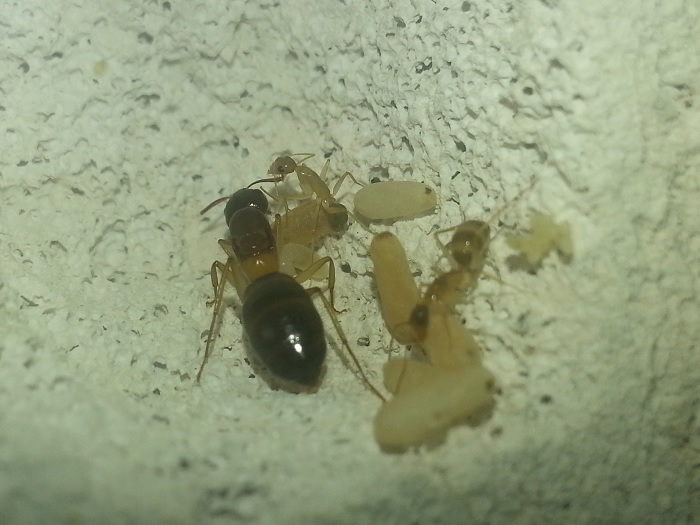
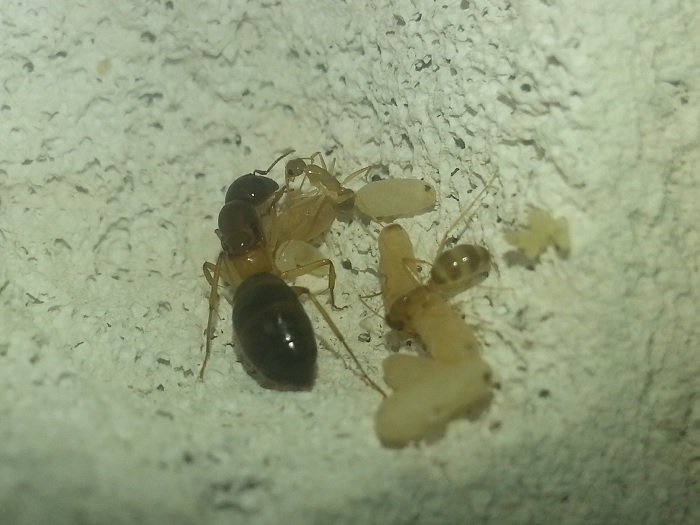
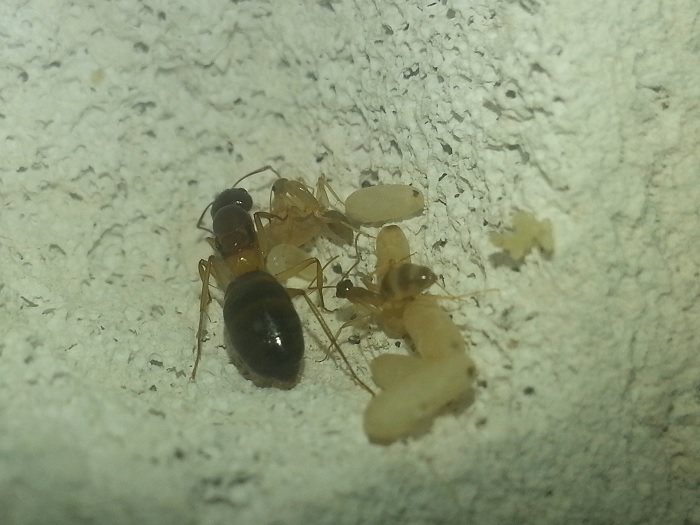
I like their colors.
I like their colors.
The colour of the workers is quite light, no sure if they may get darker as time goes.
Edited by antmaniac, February 28 2015 - 4:38 PM.
28/2/2015
The third worker has eclosed soon after the second. The queen seems be knowing when they are going to eclose and open up the cocoon for them. The new worker has all her legs tangled in a white stuff, maybe the skin she shed. The queen has taken the white stuff off and ate it afterward.
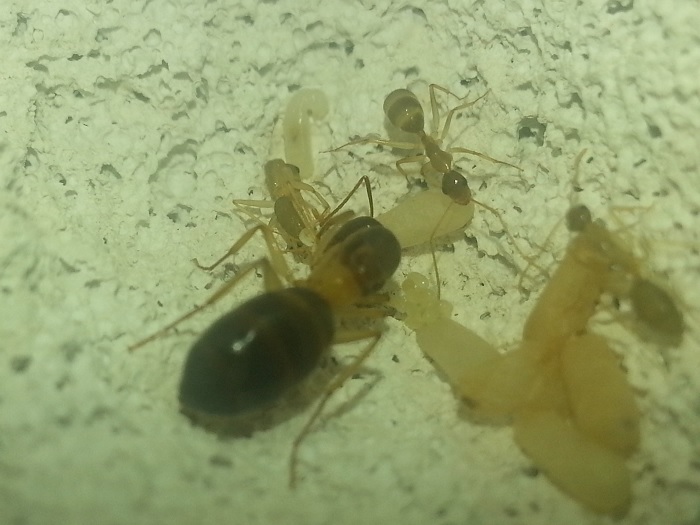
2/3/2015
4 workers now, the colony is still inactive.
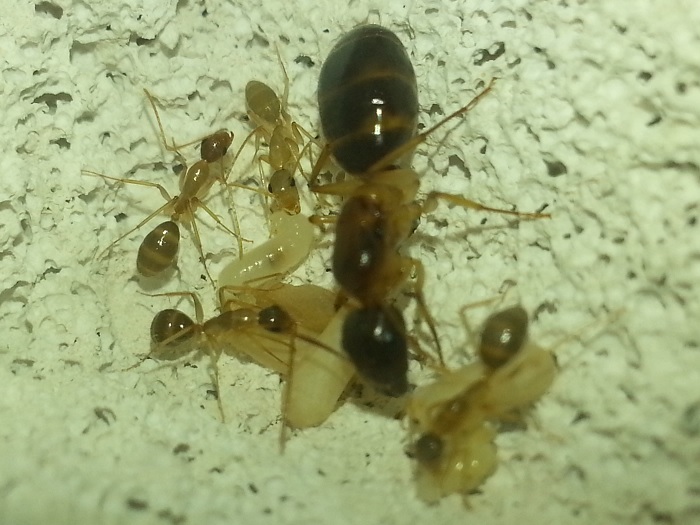
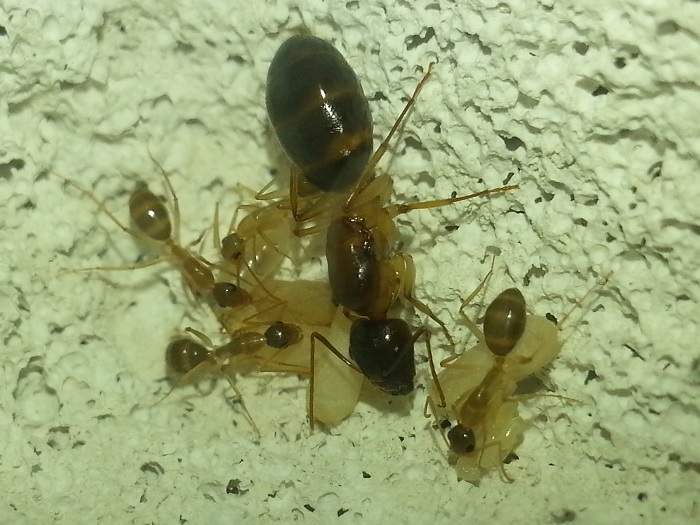
It looks like you have a few formicarium designs where a part of the block is soaking in water. How is that working out? Does it get too wet/dry or does the absorption rate of the block form the perfect gradient? Seems convenient.
Camponotus vicinus, Crematogaster 1, Crematogaster 2, Formica francoeuri, *, *, Myrmecocystus testaceus, Novomessor cockerelli, Pheidole hyatti, Pogonomyrmex californicus, Pogonomyrmex rugosus, Solenopsis invicta
WARNING: Long reading below.
Well, first of all, I think two major factors determine the suitability of the formicarium, the species of the ant and location of the formicarium.
Some species prefer dry nest while some prefer wet nest. From my observation, the queens prefer dry area over wet area. Furthermore, in rainy days, the ants would run away from the lower or wet area of the nest, I think it is just their natural instinct that flooding will drown them. Also keep in mind that some species may able to dig through ytong, so far I havent encounter this species yet.
In regards to the location, if the formicarium is indoor, no much considerations are required. However, if it is outdoor, then there are many more factors determine the suitability of the formicarium. The benefit of formicarium soaking in water is that it provides a reliable water source for a long period of time, given that the water container is big enough. Again, I havent encounter disintegration of ytong yet.
Below I will list some formicariums I created and their stories, hope they may give you some insights. I have grouped them into two styles, vertical and horizontal.
Vertical
Vertical formicariums are easy to make and require less material, which means cheaper. However, they can't have deep chambers and need things to stabilise them.
1: My very first formicarium designed for some black ants. I created a straw with melted and modified tip, which allows only workers to go outside. On the other end, blocked with honey. By the time the ants ate through the honey, their colony size should be big enough to go out and forage. The nest itself is just one big chamber carved in a slab of ytong. Iridomyrmex Sp: I put this queen in with brood, their colony grew rapidly. The formicarium was soaked in a bowl of water and I relocated them outside. But there was too much sun in this location and eventually it got overheated and dry out. The queen actually survived, but became very skinny. Lasius Sp: This time, I relocated the colony to a shady area outside and cover it with newspaper. It works out very well, until one day the whole colony got raided by a small red Pheidole Sp colony nearby. I did manage to see the queen got hold down by 2 Pheidole majors and a number of minors. This year, I have found Lasius Sp again and they are currently developing quite nicely. I plan to reuse this formicarium with improved water container, since drying out was a big concern before.
2: I created my second vertical formicarium for my Pheidole Sp, which you can find the journal in this forum. This colony has been going for one year now and is still surviving well. This formicarium has a simple outworld connected to it, which makes feeding much easier. The colony is located in a bush area, so no concerns of the sun and overheating. First issue when I moved this formicarium outdoor is the water source. The snails and other insects all came and drank from the water container. So I made a container with tight lid afterward. Second issue is the moss grew from the waste of the snails. So far it has not cause any harm to the colony. Third issue is the seed, it has sprouted in the chamber. I should not gave them seeds, but it is too late now. The colony would move upward and block the holes when it is about to rain. Feeding in an outdoor environment can also be a challenge. The honey will go watery from the condensation and other tinny ants will come and steal the foods. Ultimately, I hope this colony will able to forage by their own.
3: The latest creation of my vertical formicarium, which is shown in my Polyrhachis Sp journal. It has a huge water source and top part appear to be dry since it is no longer just a slab of ytong. However, due to this dryness, the brood can not stick to the chamber wall and would drop down, which means less usable area.
Horizontal
Horizontal formicariums require more carving and more materials. But it will provide roomy and comfort housing for your ant colony if design well.
1: My first attempt at horizontal formicarium creation. I used it on my Camponotus Consobrinus, the banded sugar ant. It was a rough design and I had issue with the water overflow the nest. I have tried to modify the design by lower the water level, but the water dried up too quick. Needless to say, I need a bigger block.
2: This time, I created a horizontal formicarium on the lid of the water container. This design worked well for a while and my Lasius Sp seems be quite happy to be in it. However, during hot sunny days, condensation started to build up. Well, that is fine, as it is quite normal. Then on the rainy days, the whole nest got flooded.
3: My most recent design, which you can see in this journal. The idea is, only part of the block is soaked in water and the ants can decide where to live. In future, when it is outdoor, the formicarium part will be covered from sun and rain while the water container part will be exposed to obtain rain water. So far I don't see any issue with this design, but then, all my design don't have any issue until I moved them outdoor. So we will have to see. This formicarium also connected to an outworld and can connect to an expansion if desired.
Other thing to be aware of is the visibility of the transparent material, which will be affected by the dust build up on their surface over time. You can either clean them once a while or if you are lazy like me, just put a cover on and remove them when need to take a photo or two.
Edited by antmaniac, March 2 2015 - 5:29 PM.
Why don't you keep your ants indoors? That way there is a lot less environmental factors that could go wrong.
That is true. However, my family doesnt support my ant keeping and I can't keep lots of them indoor. Fortunately, we got garden at home, which is like an enormous outworld. There are so many species of ants in the garden. I would see 3 different species of ants fighting over a sweet. Ants are raiding other ants constantly or have territorial dominance, such as that massive red Pheidole colony under the tree. With the extra spoon feeding, I don't see how the ants I raise would lose to other ants in the garden. If my formicarium satisfy the ants' housing requirement and desirable, I am sure they will treat it as if it is just another nest. Obviously they will be annoyed by my sneak peeking, but my Pheidole just treat it as another disturbance outside their nest and come out to guard the nest and move the brood. In their natural habitat, they can forage by themselves, this also means I don't need to look after them at all. In addition, I can observe them freely in the wild, which is not much different from indoor environment. Other than, the extra lighting effect and sometimes the annoying mosquitoes I guess. All formicariums are portable, so I can relocate them indoor for better photo shooting. However, I prefer not to, as it is quite stressful for the ants, each relocation is like earthquake to them.
4/3/2015
Worker number 5.
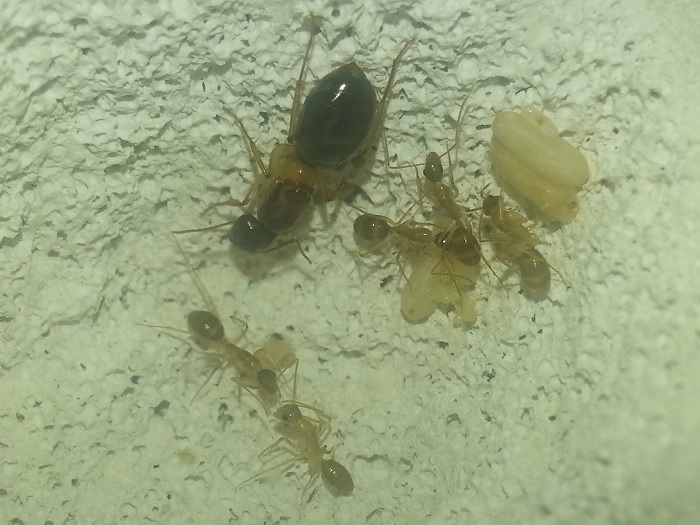
Look like there is a squatter in the formicarium. I thought this only happens in the outdoor environment.
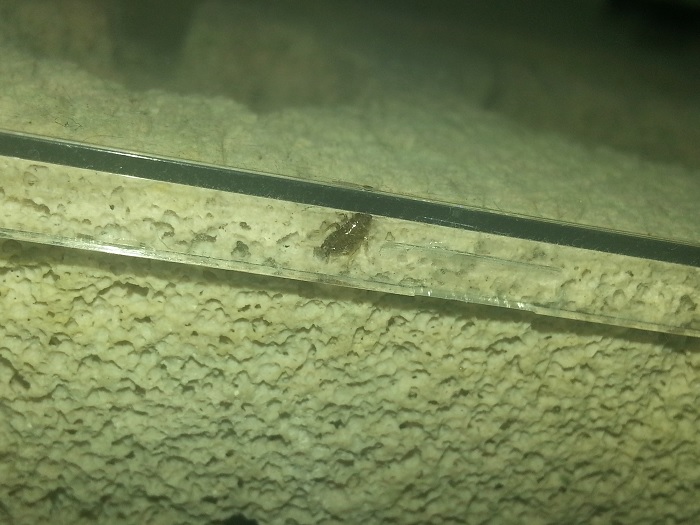
5/3/2015
One worker has started scouting around now, searching every corner slowly and looks very curious. They also moved the cocoon shells into another chamber overnight.
14/3/2015
7 workers now!
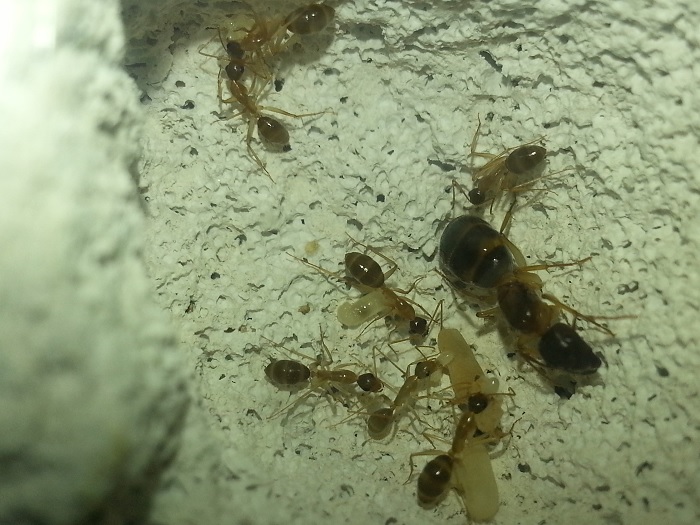
The queen is sharing the food/feeding.
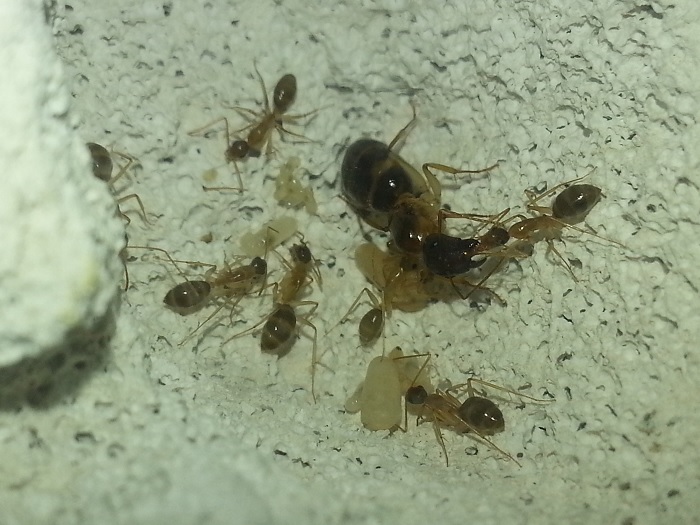
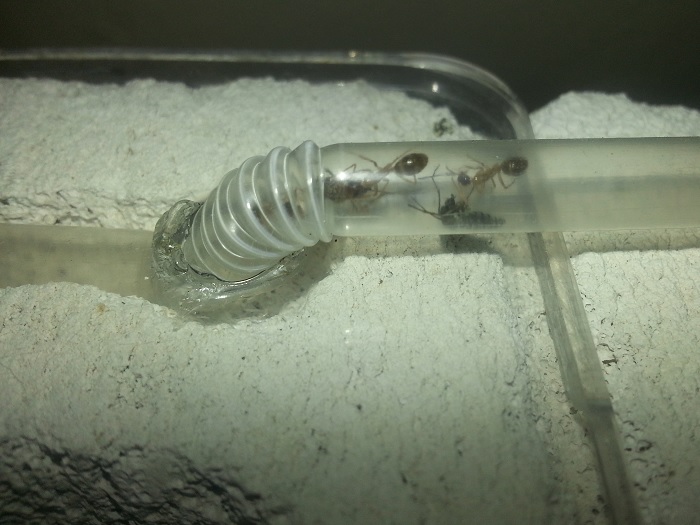
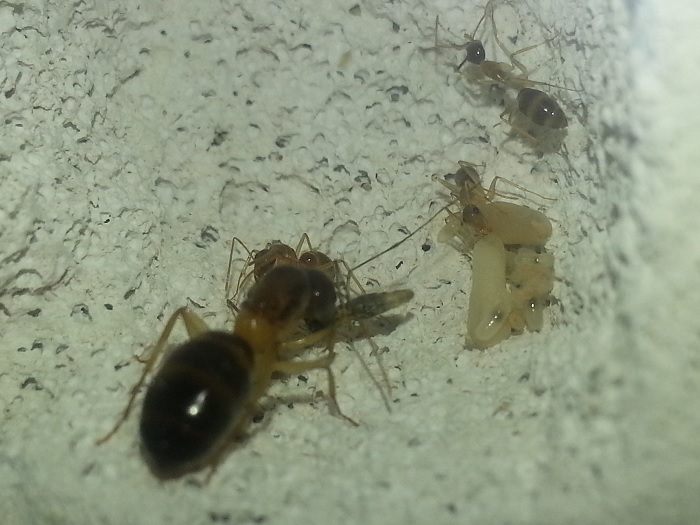
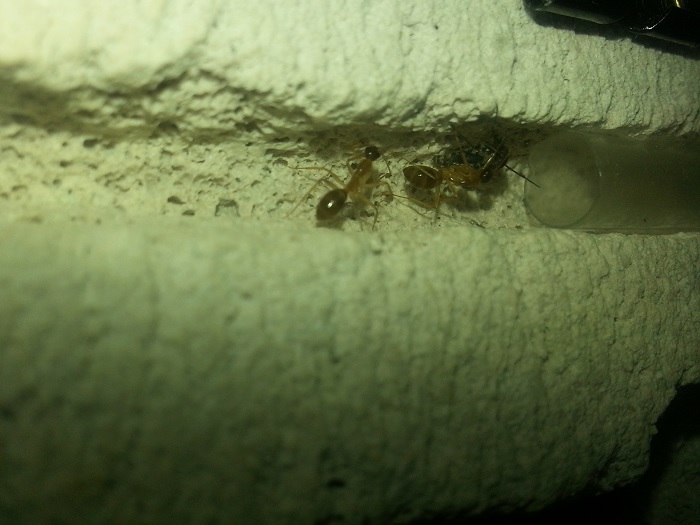
18/3/2015
8 workers now. In this photo, you can see 1 of the workers is chewing a mosquito. Although it also appears that maybe the larva underneath is actually doing the chewing and feeding the worker.
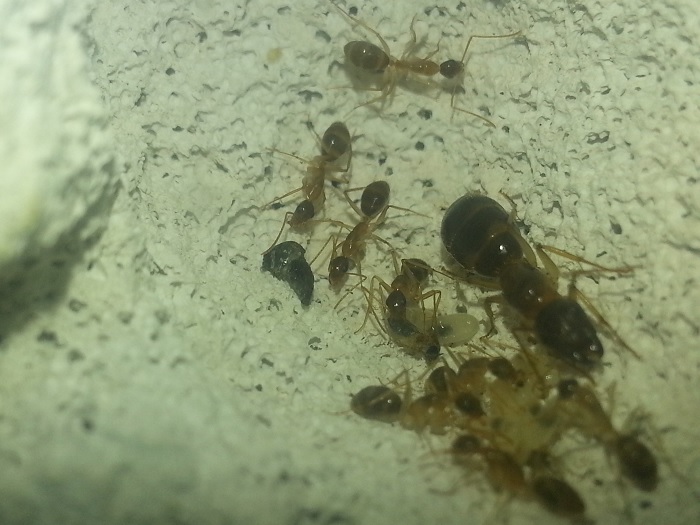
I have also included photo showing part of the outworld below, mainly to show the straw holding the honey. The larger straw on the side leads to the formicarium. Everything in the outworld can be removed, relocated and rearranged if required. Furthermore, a close up of the straw is shown in the next photo. It appears that they had made some progress in consuming the honey.
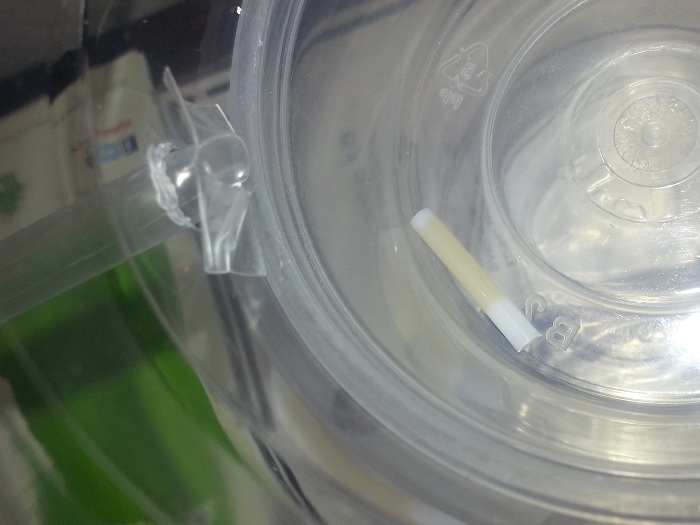

Edited by antmaniac, March 18 2015 - 2:27 AM.
0 members, 1 guests, 0 anonymous users